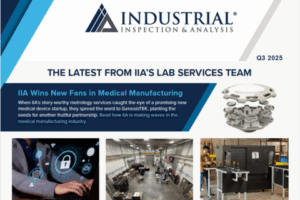Fast, flexible & accurate dimensional inspectionDimensional Inspection
3D scanning is a fast, flexible, and highly accurate way to gather data that can be analyzed to provide feedback on the accuracy of your manufacturing process.
The Dimensional Inspection Experts
Dimensional inspection (also known as: metrology services, validation, verification, product evaluation, contract inspection, and layout inspection) is performed to compare the actual condition of a manufactured part or component to that defined by engineering drawings and blueprints, metal or film templates (decreasingly), digital files and 3D CAD models (increasingly), or even a master tool or part.There are many ways to establish product definition or to define design, and even more ways to measure and inspect the actual product manufactured. That’s why IIA has amassed an impressive array of state-of-the-art measuring instruments, equipment and technology.
Talk To An Expert
Don’t see exactly what you are looking for? Or maybe you do and want more specifics or an estimate. Either way, you can call us at
470-264-5765
right now or just fill out the form below and we will respond back within 24 hours.
These technologies, coupled with our team of highly skilled, trained, and experienced professionals, allow us to provide high-quality, yet cost-effective, service that is unmatched in the industry. The end result for you is impartial, unbiased, and comprehensive dimensional measurement data you can depend on.
Our expansive, environmentally controlled laboratories are well equipped to handle virtually any inspection need, large or small, with accuracies and measurement resolutions down to mere nanometers.
We provide timely, easy-to-understand results in a variety of reporting formats, including customer-specific formats. See our Additional Inspection Specialties page for even more dimensional inspection services offered by IIA.
Types of Dimensional Inspections
Our Leading Dimensional Inspection Equipment
Bruker alicona µCMM:
Our Irvine, California lab is proud to be home to the Bruker alicona µCMM — the world’s first purely optical CMM machine. The µCMM is a game-changer for measuring extremely tight tolerances with ultra-high accuracy. Learn more.

Coordinate Measuring Machines (CMM):
- Hexagon CMMs with Analog Scanning (PC-DMIS)
- Zeiss CMMS with Analog Scanning (Calypso)
- OGP Vision CMMs (Zone3 and Measuremind)
- Hexagon Optiv Performance with Chromatic White Light Interferometry Scanning
- Hexagon Optiv Classic (PC-DMIS)
- FARO Portable CMMs with Laser Scanners
Scanning and Support Capabilities
- Hexagon HP-L 10.10 Blue Light Laser Scanner
- GOM Blue Light Laser Scanner
- LDI Surveyor 3D Laser Scanners
- Cyberscan Confocal Micro-Scanners
- Chromatic White Light Interferometry Scanning
- Analog CMM Scanning
- Robust Inventory Control System
- 2,000 lb Hoist Capacity
- Class 10,000 Clean Room Inspection
- Polishing Wheel
- Cutoff Machine
- Horizontal Bandsaw
- Parts Cleaning Station
- Wire EDM Resources
- Optical Comparators and other standard dimensional inspection equipment
- Zeiss Surfcom Profilometers
- CyberScan Laser Micro-Scanner (non-contact surface finish)
Certifications
All inspectors are certified to one or more of the following:
- CQI (Certified Quality Inspector)
- CMI (Certified Mechanical Inspector)
- CQT (Certified Quality Technician)
- CQE (Certified Quality Engineer)
- CQM (Certified Quality Manager)
- CQA (Certified Quality Auditor)
- A2LA Accredited to ISO/IEC 17025: 2005
- ASQ Certifications
- ITAR, JCP and SAM Registered
- DCS Certified
- NADCA Participation
- Federal Firearms License
- A2LA Testing Cert: 1172.01
- Duns Number: 19-993-4829
- NAICS: 541380 (Mech. Testing Lab or Services)
- Cage Code: 0GB04
- SIC Code: 8734
Resources



